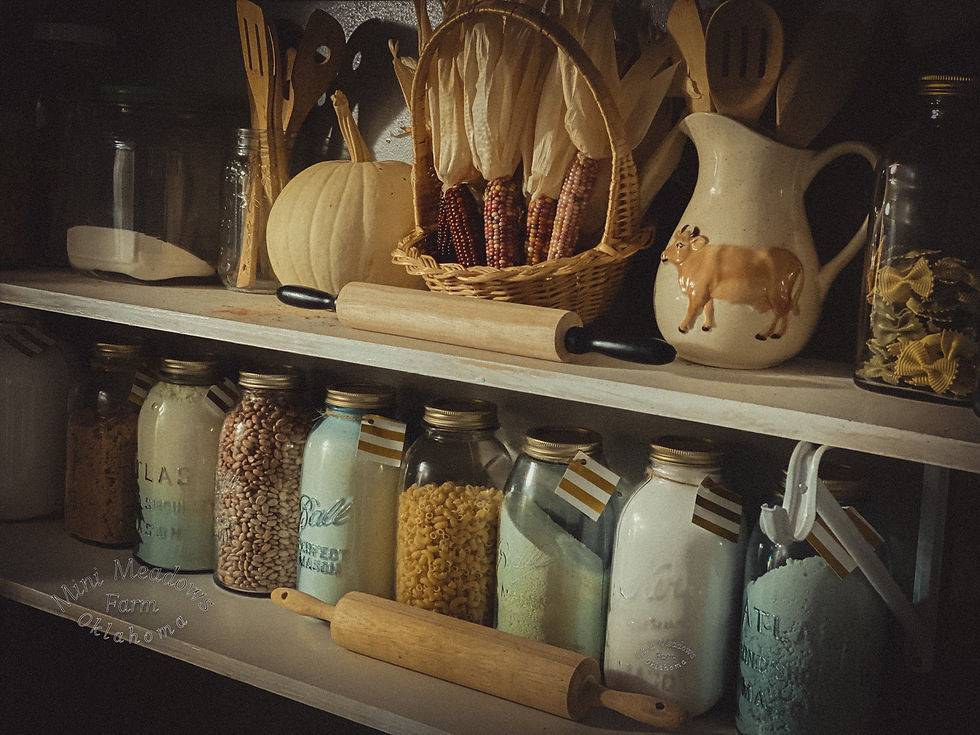The Allure of Glass Gem Corn: A History and Beyond
- kimberkay777
- Feb 8
- 3 min read
Glass Gem corn is a captivating variety that has taken the culinary and decorative worlds by storm. Its vibrant, translucent kernels have made it a popular choice for fall decorating and a versatile ingredient in various culinary creations. In this article, we will explore the origins and evolution of Glass Gem corn, its distinctive appearance, culinary uses, and how to grow and harvest it for your own garden.
Origins and Appearance:
Glass Gem corn traces its roots back to the Oklahoma Native American tribes of North America. It was carefully bred and cultivated by these tribes, who held a deep reverence for corn as a sacred plant. Specific tribes responsible for its creation remain a subject of debate, but its legacy has endured.
What sets Glass Gem corn apart is its mesmerizing array of jewel-toned kernels. Ranging from deep purples and blues to vibrant yellows, pinks, and oranges, each ear of corn is a unique kaleidoscope of colors. When held up to the light, the kernels appear translucent, hence the name “Glass Gem.”
Evolution and Culinary Uses:
Over the years, Glass Gem corn has evolved both in terms of appearance and culinary versatility. Breeders have continued to refine its characteristics, resulting in a wider range of vivid colors and even more dazzling patterns. This evolution has opened up numerous possibilities for its culinary applications.
Glass Gem corn can be used in various ways in the kitchen. Its kernels can be popped to create a visually stunning and delicious snack reminiscent of multicolored popcorn. Ground into cornmeal, it adds a touch of vibrancy to cornbread, tortillas, and other baked goods. The vibrant kernels can be used to make colorful salads, salsas, and even stunningly hued corn-based desserts.
Fall Decor and Beyond:
Beyond its culinary uses, Glass Gem corn has gained significant popularity as a fall decorating staple. Its vibrant colors make it a perfect addition to autumnal displays, harvest festivals, and Thanksgiving centerpieces. From wreaths and table centerpieces to cornucopias and decorative corn husk bundles, Glass Gem corn adds a touch of natural beauty to seasonal decorations.
Growing Glass Gem Corn:
If you’re considering growing Glass Gem corn in your own garden, you’re in for a treat. It thrives in warm climates with long growing seasons, making it an excellent choice for regions with hot summers. Glass Gem corn requires full sun, fertile soil, and regular watering for optimal growth.
To grow Glass Gem corn, start by preparing the soil in early spring, ensuring it is well-drained and rich in organic matter. Plant seeds directly into the ground and should be planted around 1-2 inches deep in rows with 2-3 seeds in each hole. Plant your crop in multiple rows or blocks of rows.
Planting just one or two long rows makes it difficult for the corn to use the wind to pollinate. Instead, plant shorter row lengths that are at least 4 to 6 rows wide to form thicker “blocks” of corn. The rows should be 30 inches apart with 6-12 inches between seeds. The height of the plants depend upon water given, but can reach up to 9 feet, typically 6 feet being average.
Harvesting and Seed Saving:
Knowing when to harvest Glass Gem corn is essential to enjoy its vibrant colors and flavorful kernels. Harvest is between 110 to 120 days. You will know when the ears are ready for harvest when the husks have dried and turned brown, and the kernels feel hard and mature. Gently peel back the husks to reveal the stunning array of colors, and harvest the ears by twisting them away from the stalk.
To save the seeds for the next planting season, allow the harvested ears to dry completely in a well-ventilated area. Once dry, remove the kernels from the cob and store them in a cool, dry place in an airtight container. Properly stored, Glass Gem corn seeds can remain viable for several years.
In conclusion, Glass Gem corn is a captivating variety that has captured the hearts and imaginations of people around the world . Its origins, vibrant appearance, and versatile culinary uses make it a remarkable addition to any garden and an ideal choice for fall decorating. Whether you’re looking to grow it for its beauty or to explore its culinary potential, Glass Gem corn is a truly extraordinary crop that offers a feast for the eyes and the taste buds!





Comments